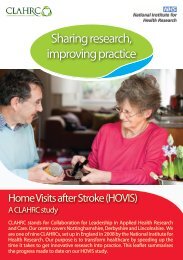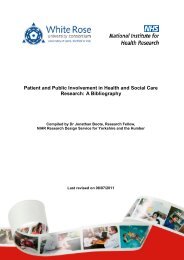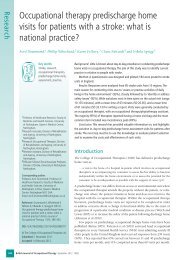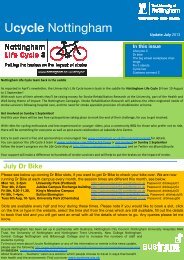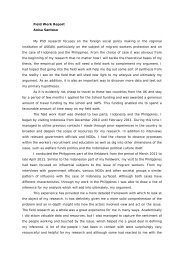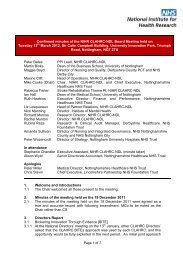The Big Conversation about the Quality of Nursing ... - CLAHRC-NDL
The Big Conversation about the Quality of Nursing ... - CLAHRC-NDL
The Big Conversation about the Quality of Nursing ... - CLAHRC-NDL
Create successful ePaper yourself
Turn your PDF publications into a flip-book with our unique Google optimized e-Paper software.
<strong>of</strong>ten do not take responsibility and need to acknowledge <strong>the</strong> limitations and clear up<br />
misunderstandings between different areas.<br />
It was highlighted that we need evidence to show that things are not in place. <strong>The</strong>re is lack <strong>of</strong><br />
ownership; we need to explore what prompts good care, and put time-frames on care as it can<br />
go on for too long. We should sharpen up our thinking, and avoid silos but also consider <strong>the</strong><br />
impact on <strong>the</strong> patient at <strong>the</strong> same time. However, does sharpening up thinking „kill‟ <strong>the</strong> Darzi<br />
principles?<br />
What can we do from a service user perspective to make <strong>the</strong>ir lives less stressful? One<br />
suggestion was to try to avoid admission in <strong>the</strong> first place, promote best practice in <strong>the</strong><br />
community. It was considered that we need people that understand both systems and use to<br />
care pathways that translate into people‟s everyday thinking.<br />
One key area that should be looked at was thought to be admission and discharge, and <strong>the</strong>re<br />
was potential here to change <strong>the</strong> processes to improve care. Discharge planning needs to start<br />
even before patients go in to hospital, for example, start thinking <strong>about</strong> pain relief and so on,<br />
however this requires a huge amount <strong>of</strong> communication, a culture shift and to think<br />
proactively. Think <strong>about</strong> long term chronic conditions, <strong>the</strong> transferability <strong>of</strong> an approach, <strong>the</strong><br />
key principles should be <strong>the</strong> same. Learn from patients who talk <strong>about</strong> <strong>the</strong> reality <strong>of</strong> <strong>the</strong>ir<br />
discharge with personal budgets. People should be named in discharge packages so <strong>the</strong>y can<br />
be identified if needed. We let people down by asking repeated questions, <strong>the</strong>re has got to be<br />
a better way than tick boxes; one person said “I blame <strong>the</strong> managers”.<br />
21






